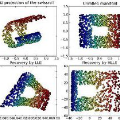Effective building pattern recognition is critical for understanding urban form, automating map generalization, and visualizing 3D city models. Most existing studies use object-independent methods based on visual perception rules and proximity graph models to extract patterns. However, because human vision is a part-based system, pattern recognition may require decomposing shapes into parts or grouping them into clusters. Existing methods may not recognize all visually aware patterns, and the proximity graph model can be inefficient. To improve efficiency and effectiveness, we integrate multi-scale data using a knowledge graph, focusing on the recognition of C-shaped building patterns. First, we use a property graph to represent the relationships between buildings within and across different scales involved in C-shaped building pattern recognition. Next, we store this knowledge graph in a graph database and convert the rules for C-shaped pattern recognition and enrichment into query conditions. Finally, we recognize and enrich C-shaped building patterns using rule-based reasoning in the built knowledge graph. We verify the effectiveness of our method using multi-scale data with three levels of detail (LODs) collected from the Gaode Map. Our results show that our method achieves a higher recall rate of 26.4% for LOD1, 20.0% for LOD2, and 9.1% for LOD3 compared to existing approaches. We also achieve recognition efficiency improvements of 0.91, 1.37, and 9.35 times, respectively.
翻译:有效的建筑模式识别对于理解城市形态,自动化地图概括和可视化3D城市模型至关重要。大多数现有研究使用基于视觉感知规则和邻近图模型的无对象方法来提取模式。然而,由于人类视觉是一个基于部件的系统,模式识别可能需要将形状分解为部件或将它们分组成聚类。现有的方法可能无法识别所有视觉感知模式,并且邻近图模型可能效率低下。为了提高效率和效果,我们使用知识图谱集成多尺度数据,着重于识别C形建筑模式。首先,我们使用属性图来表示在C形建筑模式识别中涉及的不同尺度内和尺度之间的建筑物之间的关系。然后,我们将此知识图谱存储在图形数据库中,并将C形模式识别和丰富的规则转换为查询条件。最后,我们使用基于规则的推理在构建的知识图谱中识别和丰富C形建筑模式。我们使用从高得地图收集的具有三个细节级别(LOD)的多尺度数据验证了我们方法的有效性。我们的结果表明,与现有方法相比,我们的方法在LOD1中实现了更高的召回率为26.4%,在LOD2中为20.0%,在LOD3中为9.1%。我们还分别实现了0.91、1.37和9.35倍的识别效率提高。

